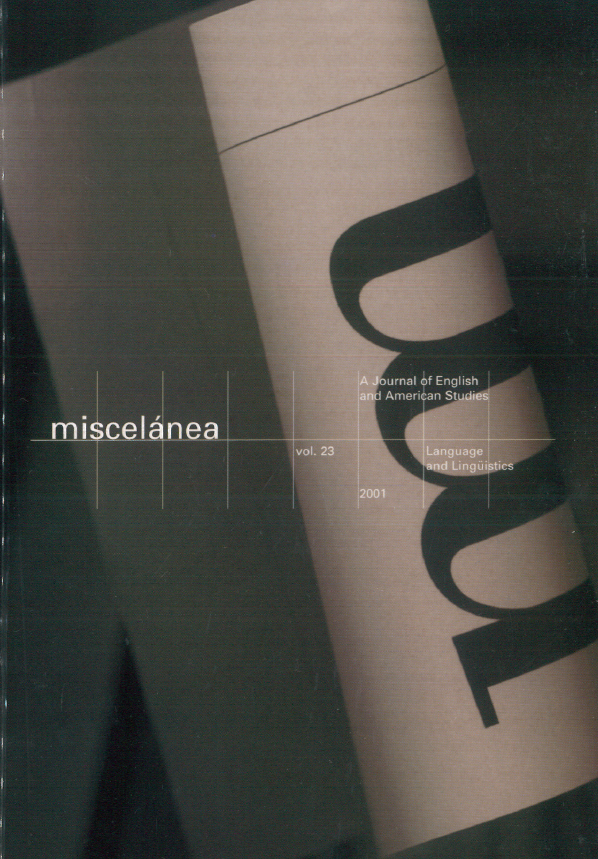De la juventud a la edad a través de la poesía inglesa antigua (con paralelos en nórdico antiguo)
DOI:
https://doi.org/10.26754/ojs_misc/mj.200110538Palabras clave:
edad, sabiduría, inglés antiguo, nórdico antiguo, anglosajonesResumen
Se ha argumentado que la edad más preeminente del hombre entre los anglosajones era el senectus. Esta opinión se basa en el hecho de que muchos textos contemporáneos enfatizan la sabiduría asociada a la edad mientras ignoran el deterioro físico que conlleva. Este artículo examina la representación de este problema en la poesía del inglés antiguo, e incorpora la literatura nórdica antigua para complementar las escasas pruebas de la primera. En primer lugar, evalúo la importancia que los anglosajones concedían a la sabiduría, y analizo los dos caminos que podían seguir los jóvenes para llegar a ser sabios: la asociación con un hombre sabio, y la experiencia del mundo. Mi análisis aporta un resultado muy concreto: a partir de los testimonios escritos del inglés antiguo se puede concluir que los anglosajones consideraban la etapa intermedia entre la juventud y la edad como la perfecta aetas. En esta edad se ha alcanzado un grado suficiente de madurez intelectual, mientras que los síntomas de decrepitud y senilidad aún no se han manifestado.
Descargas
Citas
ARNGART, Olf. (ed.). 1981, “Durham Proverbs”. Speculum 56 (2): 288-300.
ÁSMUNDARSON, Vald. (ed.). 1898. Svarfdaela Saga. Reykiavik.
AUGUSTINE. Epistola 213. PL 33, col. 966-968.
BEDE. Super Parabolas Salomonis Allegorica Expositio. Patrologia Latina 91, col. 937-1040.
BISKUPA SÖGUR. 2 vols. Kaupmannahöfn, 1862.
BOSWROTH, Joseph and Thomas Northcote TOLLER. 1898-1921. An Anglo-Saxon Dictionary. Oxford: Clarendon Press.
BROOKS, Kenneth R. (ed.). 1961. Andreas and the Fates of the Apostles. Oxford: Clarendon Press.
BURROW, John A. 1986. The Ages of Man: A Study in Medieval Writing and Thought. Oxford: Clarendon Press.
CHAMBERS, Raymond W. 1965. Widsith: A Study in Old English Heroic Legend. New York: Russell & Russell.
CLEMOES, Peter. (ed.). 1997. Alfric’s Catholic Homilies: The First Series, Text. Early English Text Society, Supplementary Series 17. Oxford: Oxford U. P.
CURTIUS, Ernest Robert. 1953. European Literature and the Latin Middle Ages. Trans. W. R. Trask. Princeton: Princeton U. P.
DESKIS, Susan E. 1996. Beowulf and the Medieval Proverb Tradition. Tempe: Medieval and Renaissance Texts and Studies.
DOVE, Mary. 1986. The Perfect Age of Man's Life. Cambridge: Cambridge U. P.
DUNNING, Thomas P. and Aland J. BLISS. (eds.). 1969. The Wanderer. New York: Appleton Century-Crofts.
ENGELHARDT, G. 1953. “On the Sequence of Beowulf's Geogo". Modern Language Notes 68 (2): 91-95.
GHELLINCK, Joseph de. 1948. “luventus, Gravitas, Senectus”. Studia Mediaevalia in Honorem admodum Reverendi Patris Raymundi Josephi Martin. Bruges: De Tempel: 39-59.
GODDEN, Malcolm. (ed.). 1979. AEfric's Catholic Homilies: The Second Series, Text. Early English Text Society, Supplementary Series 5. London/Oxford: Oxford U. P.
GORDON, Ida L. (ed.). 1966. The Seafarer. New York: Appleton-Century-Crofts.
GREGORY THE GREAT. Regulae Pastoralis. Patrologia Latina 77, col. 13-128.
HALLDORSSON, Ólafur. (ed.). 1987. Faereyinga Saga. Reykjavik: Stofnun Árna Magnússonar.
HANSEN, Elaine T. 1981. “Precepts: An Old English Instruction”. Speculum 56 (1): 1-16.
—. 1982. “Hrodgar's "sermon” in Beowulf as Parental Wisdom”. Anglo-Saxon England 10: 53-67.
HELGASON, Jón. (ed.). 1955a. Eddadigte. 3 vols. Copenhaguen: Munksgaard.
—. (ed.). 1955b. Hrafnkels Saga Freysgoda. Copenhagen: Munksgaard.
HILL, Thomas D. 1981. “The Age of Man and the World in the Old English Guthlac A”. Journal of English and Germanic Philology 80 (1): 13-21.
The Holy Bible Translated from the Latin Vulgate: Douay's version. 1914. Baltimore: John Murphy.
HOWE, Nicholas. 1985. The Old English Catalogue Poems. Anglistica 23. Copenhaguen: Rosenkilde & Bagger.
ISIDORE. Differentiarum, 2.20. Patrologia Latina 83, col. 9-98.
—. 1911. Etymologiarum sive originum libri XX. 2 vols. Ed. W. M. Lindsay. Oxford: Clarendon Press.
JEROME. 1910. Epistulae I-LXX . Ed. Isidorus Hilberg. Corpus Scriptorum Ecclesiasticorum Latinorum 54. Vienna: Tempsky, 1910.
JÓNSSON, Gudni. (ed.). 1936. Grettis Saga Ásmundarsonar. Reykjavik: Íslenzk Fornrit 7.
KLAEBER, Friedrich (ed.). 1950. Beowulf and the Fight at Finnsburg. 3rd ed. Boston: D.C. Heath.
KRAPP, George Philip and Elliott Van Kirk DOBBIE. (eds.). 1931-53. The Anglo-Saxon Poetic Records. 6 vols. New York: Columbia U. P.
LARRINGTON, Carolyne. 1993. A Store of Common Sense: Gnomic Theme and Style in Old Icelandic and Old English Wisdom Poetry. Oxford: Oxford U. P.
LESLIE, ROY F. (ed.). 1966. The Wanderer. Manchester: Manchester U. P.
MALONE, Kemp. (ed.). 1962. Widsith. Anglistica 13. Copenhagen: Rosenkilde & Bagger.
NORDAL, Sigurdur. (ed.). 1933. Egils Saga Skalla- Grímssonar. Reykjavik: Íslenzk Fornrit 2.
ROBERTS, Jane. (ed.). 1979. Guthlac Poems of the Exeter Book. Oxford: Clarendon Press.
SEARS, Elizabeth. 1986. The Ages of Man: Medieval Interpretations of the Life Cycle. Princeton: Princeton U. P.
SHIPPEY, T. A. 1976. Poems of Wisdom and Learning in Old English. Cambridge: D.S. Brewer.
SVEINSSON, Einar ÓI. (ed.). 1954. Brennu-Njáls Saga. Reykjavik: Íslenzk Fornrit 12.
SWEET, Henry. (ed.). 1871-72. King Alfred's West-Saxon Version of Gregory's Pastoral Care. Early English Text Society, Original Series 45, 50. London.
THORPE, Benjamin. (ed.). 1846. The Homilies of the Anglo-Saxons. Vol. 2. London.
WEBER, Robert et al. (eds.). 1994. Biblia Sacra luxta Vulgatam Versionem. (4" edition). Stuttgart: Deutsche Bibelgesellschaft.
WILLIAMS, Blanche Cotton. 1914. Gnomic Poetry in Anglo-Saxon. New York: Columbia U.P.
Descargas
Publicado
Cómo citar
Número
Sección
Licencia
Derechos de autor 2001 Jordi Sánchez Martí

Esta obra está bajo una licencia internacional Creative Commons Atribución-NoComercial 4.0.


